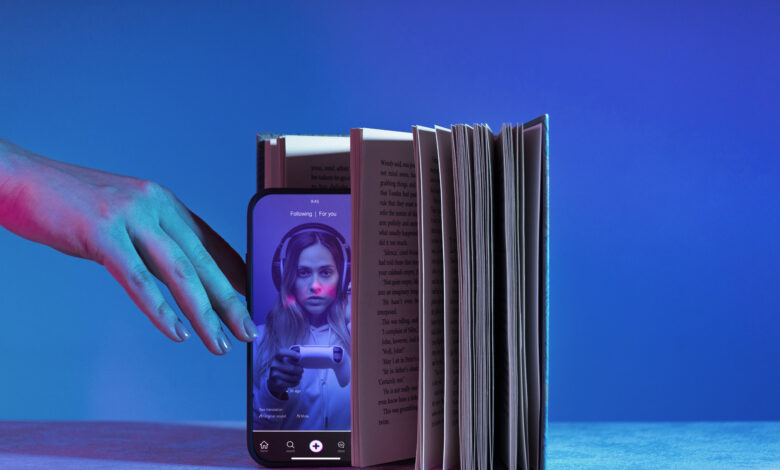
AI-powered visual storytelling is changing the way you create and share stories. With tools that use artificial intelligence, it’s easier than ever to turn your ideas into engaging videos, images, or animations without advanced technical skills. AI can help you visualize your story, guide your creative process, and even automate parts of the work so you can focus on your message.
New platforms like LTX Studio give you access to features that let you experiment and collaborate with others. You can start with a simple outline or a few images, and AI will help you shape your project, offering ideas and options as you go. These advances make storytelling more flexible, fun, and open to everyone.
Key Takeaways
- AI makes visual storytelling easier and more creative
- Platforms help you build and share stories faster
- You can use AI tools for both solo and group projects
Understanding AI-Powered Visual Storytelling
AI-powered visual storytelling uses artificial intelligence to create, enhance, and deliver visual stories. This approach combines digital images, AI algorithms, and user input to generate compelling content for education, marketing, and entertainment.
Defining AI-Powered Visual Storytelling
AI-powered visual storytelling is the use of advanced technology—especially generative AI—to automate or improve how visuals and stories are created and shared. Instead of needing strong artistic or technical skills, you can use creative AI solutions to turn ideas or text into visual narratives.
These AI-driven storytelling tools can generate artwork, edit photos, or even combine images with written stories. Anyone can tell stories visually, whether for personal, business, or educational uses. The process is direct and lets you control details like style, theme, or mood.
Major platforms now let you upload a script, description, or outline that AI transforms into slides, animated videos, or infographics. This new approach makes storytelling faster, more accessible, and adaptable for different needs.
Fundamental Concepts and Technologies
At the heart of AI-powered visual storytelling are technologies like machine learning, computer vision, and natural language processing. Generative AI technology—like DALL-E and Midjourney—can create new images from text prompts. This means you can describe what you want, and the AI produces custom visuals.
Key elements that power these systems include:
- Training Data: AI models are trained on massive datasets of images and stories.
- Image Generation: Algorithms produce original visuals that match your ideas.
- Text-to-Image Integration: Combining written content with visuals for richer narratives.
These tools allow you to experiment with different visuals, layouts, and formats instantly. You can edit or revise until you are satisfied, making the creative process flexible and efficient.
Evolution of Visual Storytelling with AI
Visual storytelling has evolved from simple drawings and photographs to dynamic digital stories shaped by AI. Early methods required skilled artists or designers, but modern creative AI solutions make this process easier for everyone.
Recent innovations let brands customize content for different audiences using AI-driven storytelling tools. For example, companies can quickly adapt visuals to different regions or languages, improving engagement and understanding. Businesses combining these tools with professional product photography in Nashville achieve even stronger results, as authentic imagery enhances the emotional appeal of AI-powered stories. Interactive stories, AI-generated animations, and adaptive presentations are now common.
You can also use AI to analyze audience reactions and adjust stories in real time. As generative AI technology improves, it continues to shape how stories are created, shared, and experienced across many fields.
Essential Tools and Platforms
AI-powered visual storytelling uses specialized tools to speed up production, improve creativity, and save costs. These platforms offer solutions for making videos, generating scripts and storyboards, and creating custom characters and assets.
AI Video Production Solutions
AI video production platforms let you make high-quality videos with little manual effort. You can use AI filmmaking platforms like Synthesia, Runway, or Pictory to turn text, images, or even spoken prompts into finished videos.
Such tools usually provide features like automatic scene changes, AI-driven voiceovers, and real-time video editing. Some tools create explainer videos or social media content, while others let you make longer films.
These solutions support script-to-storyboard conversion and often offer built-in templates for fast results. Many AI content creation platforms include direct publishing or exporting to popular formats, making it easy to share your stories across digital channels.
AI Storyboard and Script Generators
AI storyboard generators, such as Storyboard That and Boords, quickly turn your written scripts into visual sequences. These platforms use AI to analyze your script, then suggest scenes, angles, and pacing that fit your story.
With script-to-storyboard conversion, you can speed up the planning stage and reduce the risk of missing key plot moments. Features like automated layout, background suggestions, and shot lists help structure your story clearly. Some platforms support collaboration, letting multiple users edit and comment in real-time.
These tools are useful for everyone from individual creators to marketing teams, as you can make and revise storyboards quickly to fit any kind of project.
AI Character and Asset Creation
AI character generators like Character.AI, Ready Player Me, and Reallusion Character Creator let you design unique, customizable characters for your stories. You can control details such as face shape, clothing, gestures, and expressions.
Most platforms include asset libraries with props, backgrounds, and effects to build immersive settings. AI-powered tools speed up character customization and help maintain consistent art styles throughout your project.
Asset creation tools can work alongside your AI video or storyboard platform, letting you import generated assets directly into your video scenes. This helps you create engaging visual stories even if you do not have traditional art or animation skills.
Automating the Storytelling Process
AI-powered tools make visual storytelling faster and more efficient for creators and brands. You can automate editing, generate narratives, and speed up content production.
Automated Editing and Content Creation
Automated editing helps you save time by using AI video editing software that detects key scenes, removes pauses, and even matches clips to background music. These tools let you upload raw footage and receive a polished video in minutes.
Key benefits:
- Consistent style and quality across content
- Quick turnaround for social media and marketing
- Fewer manual edits required
Many platforms also offer features like automatic captioning, color correction, and scene transitions. This automation is especially useful for brands that need to produce a lot of video content for different platforms.
Narrative Generation with AI
AI can help you craft stories by analyzing data and suggesting text, visuals, or both. Tools like AI pitch deck generators create clear presentation slides by turning your ideas and data into a logical story flow.
These systems use algorithms to understand what elements make a good story. They can highlight trends or key points from your input, making your messages clearer for audiences.
Many narrative-focused AIs pull from templates or recognized story structures. This makes it simple to turn data or events into a presentation, marketing video, or infographic, all with minimal effort.
Content Creation Automation Techniques
AI-driven content creation relies on several practical techniques:
- Template automation: Fill in text and images automatically
- Batch processing: Edit or generate multiple pieces at once
- Text-to-video tools: Turn scripts or outlines into video clips
- Data visualization: Create charts and graphics from spreadsheets
For brands and creators, content creation automation can mean faster campaign launches and less time spent on repetitive tasks. You can publish updates, stories, and reports regularly without much manual input.
These techniques help you scale visual storytelling while maintaining consistency and accuracy. Many leading marketing and media teams use these tools to stay competitive and reach wider audiences.
Collaboration and Creative Workflow
AI is making it easier for teams to work together on visual stories. You can quickly share, edit, and build on ideas without waiting for files to send or versions to update.
Real-Time Collaboration Tools
With real-time collaboration, you and your team can work on the same project at once, no matter where you are. Tools powered by AI let you edit images, write scripts, or add effects together, all in one platform. These platforms often provide live feedback and suggestions, which can speed up your workflow.
You can see changes as they happen, reducing mistakes and saving time. Some tools even track each user’s contributions, so it’s easy to know who made what change. This supports better teamwork and keeps projects organized.
Benefits of Real-Time Collaboration:
- Faster decision-making
- Fewer version-control problems
- Better idea sharing
AI also helps by giving creative prompts or fixing issues as you work. You spend less time on technical details and more on creative choices.
Collaborative Video Editing
Collaborative video editing lets several people work on a video project at the same time. AI-powered platforms make it easy to trim clips, add effects, or organize scenes without needing to trade files back and forth.
You and your teammates can leave comments, highlight parts for revision, or assign tasks within the editing platform. This means projects move faster, and everyone stays on the same page.
Features found in collaborative video editing tools:
- Shared timelines
- Instant previews
- Automated scene detection
- Cloud-based storage
AI suggestions can speed up editing by recommending cuts or syncing audio. With these features, your whole team can focus on telling a better story, not just handling files.
Advanced Strategies and Future Trends
AI is changing how you create, edit, and share visual stories. New techniques and advanced tools are allowing you to develop more creative films and videos, while predicting trends before they happen.
Emerging AI Filmmaking Techniques
AI is now used to help write scripts, design characters, and match visuals with music or sound that fits the mood. Some tools let you turn a short idea into a full video with voices, animations, and effects.
List of Key AI Techniques:
- AI-driven scriptwriting
- Automated video editing
- Scene generation using prompts
- AI voice and facial animation
These techniques speed up your workflow. Instead of spending hours editing, you can use AI to sort through footage or suggest new shots. AI also helps you create custom trailers or short films by analyzing big sets of data quickly.
You can now create stories with branching paths or interactive elements. Audiences can join in, making each viewing a little different. AI makes this kind of dynamic storytelling possible and more affordable.
Integrating Advanced Filmmaking Tools
You can use advanced tools powered by AI in almost every step of production. Many major video editors now have features like smart color correction, noise removal, and automatic subtitles. These upgrades help you keep your work looking sharp and sounding clean.
Table: Example Advanced AI Tools and Features
| Tool Type | Example Feature |
| Editing Software | Scene detection |
| Animation Platforms | AI-generated characters |
| Audio Enhancement | Automatic noise cleaning |
| Subtitling Services | Real-time speech-to-text |
AI helps with organizing and archiving footage by tagging scenes and faces. You can automate these tasks, giving you more time to focus on storytelling. Advanced editing platforms also allow you to collaborate online in real time, using AI to sync your team’s work together easily.
Frequently Asked Questions
AI now plays a direct role in turning ideas into storyboards and converting text into visuals. You can choose from a range of tools to suit your storytelling needs, from free web-based platforms to specialized video creators.
How does AI contribute to the process of generating storyboards?
AI helps by quickly turning your written descriptions or scripts into visual scenes. Many AI storyboard tools use image generation and scene-matching, making it faster to build and revise storyboards. This allows you to focus on story flow, while the AI handles the technical aspect of image placement and design.
What are the leading AI tools currently available for enhancing storytelling?
Some popular AI storytelling tools include Midjourney, DALL-E, and ArtAI4DS for creating images. Canva and Adobe Express offer AI features for storyboarding and visual design. For more interactive or video stories, Storywizard and RunwayML are among the leading options.
Is there an AI solution for converting narrative text into visual content?
Yes, several AI systems can generate images and visuals from text. Tools like DALL-E and StabilityAI let you enter written prompts to get matching pictures. Some applications can break down your story paragraph by paragraph and create a set of images or visuals for each part.
Which platforms offer free AI-powered storytelling capabilities?
Free options include Canva’s AI image tools, Google’s AutoDraw, and the basic versions of platforms like Storywizard. Some websites offer limited free credits each month for AI image generation. Always check each tool’s free plan details, as features can change.
Can AI-driven platforms support video storytelling and production?
Yes, platforms like Synthesia, Pictory, and RunwayML allow you to make simple videos using AI. You can input text or images, and the AI creates scenes, adds voice narration, or animates characters. These tools are helpful for making educational clips and social media videos.
What innovations have AI brought to interactive digital storytelling?
AI can now let stories react to user choices, changing the narrative direction in real time. Some newer apps use AI to design custom endings or generate dialogue based on what you do in the story. Interactive AI storytelling is becoming more common in education and digital games.




